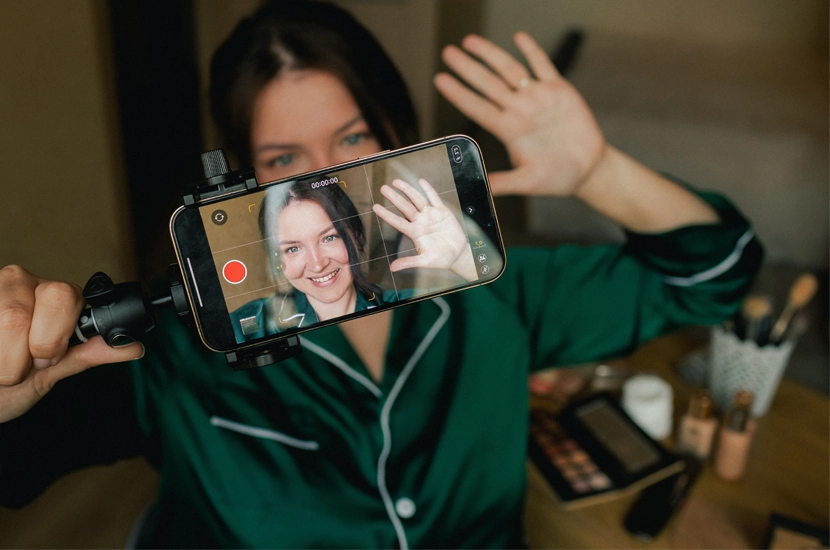Because a large part of brand communication is exhausted where attention is now won: in fast-moving, mobile flows, governed by platform codes. Consumers are no longer just looking for proof, they want usage. This is exactly the terrain of UGC (User Generated Content), content created by users, customers or communities, which shows a product in its true context, without superfluous varnish.
A context conducive to UGC authenticity
UGC is not a passing fad, it’s the most operational response to three major trends. First, advertising saturation and the distrust that goes with it: we scroll faster, we filter better, we immediately detect “too clean” content that looks like an ad. Then there’s the rise of short, vertical formats, which impose a language: get straight to the point, speak simply, prove quickly. Finally, the rise of social commerce, where recommendation, demonstration and purchase are all aligned in the same interface. The boundary between media, shop window and checkout is becoming thinner, and UGC is taking the place of a credible salesperson.
In this respect, UGC lies at the frontier between influencer marketing and social media tactics. It’s a transversal lever that cuts across the entire journey: it attracts attention because it resembles the flow, nurtures consideration by responding to real objections, triggers conversion by providing the missing proof in the right place, and prolongs the post-purchase relationship by turning satisfied customers into influencers. It speaks the language of platforms, but it serves concrete business objectives: lower acquisition costs, higher conversion rates, reduced after-sales service when tutorials are clear, continuous product improvement when the community provides feedback on usage.
There’s one condition: UGC is only effective if it’s framed. Quality, rights and brand safety are not left to chance. We need to organize collection, clarify authorizations and measure real impact, not just “likes”. In other words, UGC is not a style, it’s a method. And that’s precisely what this article proposes: to understand its driving forces, choose the formats that count, integrate it intelligently into the funnel and derive performance from it, without losing sight of brand consistency.
What is UGC?
User Generated Content (UGC) refers to content (opinions, photos, videos, posts) created spontaneously or on demand by a brand’s users. Perceived as authentic and credible, UGC has become a pillar of content strategies: it reassures, engages and influences purchase, particularly on mobile and social networks. UGC can be integrated into product pages, paid campaigns, emails and social networks.
Origins and development
UGCs weren’t born with TikTok! They have their roots in the web’s earliest participative spaces (forums, blogs, Usenet, fan communities), where Internet users were already posting opinions, tutorials and reviews. The term came into its own in the mid-2000s with the rise of social networking. The arrival of the smartphone and vertical video democratized continuous production, and brands saw it as ready-to-use social proof. As a result, UGC evolved from a DIY community to a structured marketing lever.
The different UGC formats
- Organic customer UGCs arise spontaneously from customers: they provide highly credible social proof, but are difficult to control (quality, framing, messages) and require curation and rights management before a brand can reuse them.
- Creative UGCs are co-created with creators via a brief, offering a high degree of control over angles, formats and deadlines. They benefit from clear usage rights, enabling them to be used in your Ads campaigns, at the price of a production cost and an obligation of transparency (“paid partnership”).
- Ambassador UGCs are produced by giving the floor to brand ambassador customers. They’re halfway between customer UGCs and creative UGCs, since their characteristics are identical to those of customer UGCs, but they’re produced at the brand’s request and within a specific framework.
The main UGC formats
- Customer reviews: reassurance about quality/performance. Can be published on product pages, abandonment emails, retargeting.
- Visual content: photos, videos, stories, reels. They’re well suited for product page carousels and ads.
- Textual content: comments, posts, feedback on forums/LinkedIn.
- Influencer UGC / creator UGC: paid/co-briefed content, designed for ads and landing pages.
- B2B UGC: testimonials, case studies, professional reviews, customer team posts.
Each type offers a different level of control and spontaneity. For example, a spontaneous customer post on Instagram creates organic credibility, while a brand-commissioned UGC combines authenticity and message control.
Examples of UGC created by the Effinity studio
UGC AD
UGC Lefebvre-Dalloz
UGC Coupon Network
Why does UGC perform?
UGC works because it reverses the logic of advertising: instead of a brand promise, we see real use, driven by peers. This shift fosters trust. Consumers no longer judge a speech, they observe a proof. The form makes a major contribution to this: imperfect shots, natural lighting, conversational tone… Everything that, in a traditional creation, would be a flaw, here becomes an indication of authenticity. The eye recognizes life, not the studio.
Added to this is a cultural effect: UGC embraces the codes of the platforms, picks up on their trends and dialogues with their micro-communities. It multiplies usage contexts and, in so doing, responds to more objections. The same product told by a student, a parent or a professional does not illustrate the same story, but they all reinforce the credibility of the message.
Finally, the creative “long tail” comes into its own: it’s better to have ten honest pieces of content in circulation than a single over-exploited “creative hero”. The diversity of angles refreshes attention, feeds continuous A/B testing and limits advertising fatigue, provided that production is supervised and measures something other than vanity! Ultimately, all that counts is the effect on consideration and conversion.
Hook or the art of catching an eye in a hurry
The hook is the attack of a UGC: the first 1 to 3 seconds that stop the thumb and establish a clear promise. It’s a narrative trigger (question, quantified benefit, annoyance, before/after result, instant demonstration) formulated with the language and codes of the platform that hosts it. It must name the audience’s problem, announce the solution and give a reason to stay, often with a strong visual signal, readable screen text and catchy sound. Without hook, even good content goes unnoticed; with it, everything becomes possible…
Where does UGC come into play in the conversion tunnel?
- At the top of the tunnel, the UGC captures attention because it resembles the flow into which it is inserted. A trendy sound, an effective hook, a benefit demonstrated in the first few seconds: the promise is short, the proof immediate.
- In the middle of the tunnel, the content changes register. Honest comparisons, “problem-solution” tests, mini-demonstrations: objections are addressed, compatibility is demonstrated, ease of use is reassured. The visit to the site then becomes a natural extension of the viewing experience, not a break with it.
- At the bottom of the tunnel, UGC reappears where doubt still lingers: on product sheets, in the shopping cart, sometimes even in the checkout. A relevant testimonial, a short usage video or a recent, detailed review can sway the decision.
- After the purchase, they continue to act: sharing their experience, tips for use, reasoned feedback… Satisfied customers become the best amplifiers, and the brand, if it listens to them, converts this feedback into concrete improvements. The key here is consistency: at each stage, a format, a promise, a clear call to action.
The UGC recipe
In concrete terms, good UGC content is based on a simple but strategic structure:
- Hook: from 0 to 3 seconds: grab immediate attention.
- Introduction: anchor the video in a realistic, everyday situation.
- Product: show off the product, make it desirable and useful.
- Argumentation: the designer shares his sincere opinion and real benefits.
- Call-to-action: a light, not overly commercial formula that encourages action.
It’s this combination of simplicity and authenticity that makes UGC so successful.
What KPIs are needed to measure the impact of UGC?
Acquisition
- Reach: number of unique users exposed to your UGC.
Objective: expand the qualified audience. - Video views: total readings counted according to platform thresholds (e.g. 3 s).
Tracking: unique vs. total views. - VTR (View-Through Rate) = complete views ÷ total views.
Reading: the higher it is, the more attention the UGC attracts. - CTR (Click-Through Rate) = clicks ÷ impressions.
Reading: sensitivity of UGC format to call to action. - CPC (Cost Per Click) = spend ÷ clicks.
- CPV (Cost Per View) = expenditure ÷ views (or views ≥ threshold).
- Optimization: compare UGC vs. branded assets on the same audience sets.
Conversion
- CR (Conversion Rate) = orders ÷ sessions (or clicks).
Compare: CR product pages with and without UGC - CR by location: measure the impact of the UGC block according to its position (top of page, under reviews, etc.).
- AOV (Average Order Value / Panier moyen) = revenue ÷ orders.
Commitment
- Engagement rate = (likes + comments + shares + saves) ÷ reach.
Tip: normalize by format type (photo, real, short). - Viewing time: average duration per view and cumulative total.
Effinity, a creative studio that manages the entire UGC production chain
Effinity helps brands produce high-performance UGC. Whether it’s with customer ambassadors, drawn from the brand’s customer base, or with creators selected according to their profile. In the latter case, we start by finding the right faces and voices: creators whose sector, tone and aesthetic resonate with your audience. The brief is then drawn up with your teams, to hone the key messages and align them with your campaigns, without erasing the personalities of those who carry them.
We then ensure that the production runs smoothly, thinking “social native”: sober and authentic filming, scripting to the rhythm of the platforms, attention to lighting and framing to catch the eye without betraying reality. When editing, we favor vivid cuts, systematic subtitling and a variety of formats (TikTok, Meta, YouTube Shorts, Google Ads) to ensure that every second serves the intention.
The creative dialogue between your brand, the creator and our teams remains open right to the end: rapid iterations, adjustments of tone, retouching of sequences to match your identity and current trends. The result is creations that are ready to perform, tested before deployment, optimized for distribution and flexible enough to last.
If you’d like to implement this marketing leverage or evaluate its potential for your brand, please don’t hesitate to contact us.




